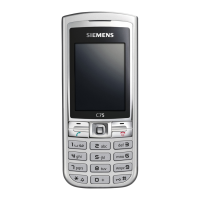Company Confidential s Com
Copyright 2005© Siemens AG
Page 24 of 37
Service Repair Documentation
Level 2.5e – C75
Release 1.0
All displays need a supply voltage of VDD_2.9 = 2.90 V. Four white side-shooter LEDs for
illumination are mounted on the module FPC. The current for the LEDs is limited to max. 18
mA by a current sink on the mobile phone PCB. All four LEDs are in serial. The voltage for
the 3 LEDs is VBoost
For data transmission an 4-wire serial interface with a maximum transfer-rate of 13 Mbit/s is
used.
5.2.8 Camera, Display ASIC
For the interface between S-GOLDlite, camera and display a graphics engine chip called
S1D13716 from Epson is used. By using the SSC interface the S-GOLDlite communicates
with this graphic engine chip. The Camera ASIC has a second SSC interface to adapt the
display. Over an I2C interface, provided by the S1D13716, the camera-module can be
initialised; the picture-data output of the camera goes over a parallel 8-bit interface
There are three modes available:
a) Bypass mode:
In this mode the S1D13716 is transparent regarding the display. The S-GOLDlite
communicates “directly” with the display.
b) Camera View Mode:
In this mode the S1D13716 transfers the picture – data from the camera directly to
the display. A resizing and compressing engine is available to reduce the data
amount to the display. So the preview can be done without using the SGOD
performance.
c) Camera Capture Mode:
In this mode the picture – data from the camera is sent to the SGOLD. There are resizing and
compressing engines available to reduce the data-stream to the SGOLD-lite
6 IRDA
A Low-Power infrared data interface is supporting transmission rates up to 115.2kbps (Slow
IrDA). As a Low-Power-Device, the infrared data interface has a transmission range of at
least:
• 20cm to other Low-Power-Devices and
• 30cm to Standard-Devices
It is not possible to use the Bluetooth and the IRDA interface at the same time.

